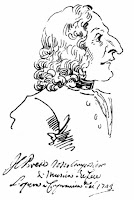 |
| Riccardo Muti conducts the Chicago Symphony Orchestra in Mussorgsky's Pictures at an Exhibition, orchestrated by Maurice Ravel. |
REVIEW
Chicago Symphony Orchestra, Renée and Henry Segerstrom Concert Hall,
Costa Mesa
Costa Mesa
DAVID J BROWN
 |
| Riccardo Muti. |
Indeed, that generosity was manifest before the concert itself when, in an interview with Classical KUSC’s Brian Lauritzen, the orchestra’s Principal tuba player Gene Pokorny and piccolo/flutist Jennifer Gunn gave patently sincere and heartfelt tributes both to their colleagues as individuals and to the CSO’s collective identity and commitment. And the generosity extended to Maestro Muti himself, who before raising his baton to launch Beethoven’s Seventh Symphony, requested the audience to stand for a minute’s silence in memory of the victims of California’s two recent mass shootings at Monterey Park and Oakland.
As for the performance of Beethoven’s Symphony No. 7 in A major, Op. 92, “generous” was an appropriate epithet as well. Lasting a solid 42 minutes, due to a (yes, generous) clutch of repeats which included the expositions of both the first movement and finale and omitted only the scherzo second half in the labyrinth that is the symphony’s Presto third movement, it had a warmth, amplitude and freshness that belied the fact that these players must have performed the symphony countless times.
Maestro Muti’s tempo for the first movement’s long Poco sostenuto introduction couldn’t have been far off Beethoven’s requested metronome of quarter note=69, resulting not so much in a sense of wide-ranging preparation for what is to come, but rather of the main drama of the movement already being under way but just beneath the surface, with the uprushing dotted scalic figures that pervade the introduction having a feeling of positive eagerness to “get going.”
 |
| Beethoven in 1814, two years after completing the Seventh Symphony. |
The second movement Allegretto maintained a steady, implacable tread, balancing breadth and forward motion, with in its opening measures the lower strings carefully distinguishing between piano and pianissimo statements of the main theme. Both the Presto and the Allegro con brio finale had all the requisite energy and precision without any speed records being attempted. Beethoven marks no speeding-up for the finale's tumultuous coda, and this performance had no gratuitous hastening, simply a master conductor and his great orchestra enabling Beethoven's cumulation of harmonic tension and dynamic pressure (the only place where his climaxes escalate from fortissimo to fff) to do all the heavy lifting necessary.
 |
| Mussorgsky in 1874, the year that he composed Pictures at an Exhibition. |
Along with all else that it is, the Mussorgsky/Ravel Pictures is also a real “concerto for orchestra,” and its opening Promenade immediately demonstrated how justified was tubaist Gene Pokorny’s admiration for his fellow CSO brass players, who richly clothed Mussorgsky’s musical self-portrait, arriving as spectator and admirer of his late friend Viktor Hartmann’s drawings and paintings.
Comparably showcased were the orchestra’s lower woodwind in I Gnomus and II The Old Castle, separated by the Promenade this time truncated, and as thoughtful in its cool low horn and high woodwind alternations as the opening had been brazenly confident. After the spectator shakes himself back to deliberate attention in a second intercalated Promenade, his attention is drawn to III Tuileries, but here the children’s play, delicately delineated in upper woodwind and strings, was somewhat more sedate than is usually the case. Then Mr. Pokorny's fellow low brass player Michael Mulcahy came to the fore on tenor tuba with as songfully eloquent a solo to open IV Bydlo as I have ever heard.
 |
| Maurice Ravel in 1925, three years after Koussevitzky's commission to orchestrate Pictures at an Exhibition. |
In VI Samuel Goldenberg and Schmuyle, the latter’s stuttering muted trumpet was less wheedling and more assertive than we normally hear, suggesting that for once he was giving his overbearing countryman as good as he got. As with the previous fast movements, VII The Market Place at Limoges scurried a little less, but the plunge into VIII Catacombs was as awe-inspiring as ever, as was the precipitation from the peak of IX The Hut on Fowl’s Legs (Baba-Yaga)’s flight to the splendor of X The Great Gate of Kiev.
 |
| Viktor Hartmann's unbuilt design for the Bogatyr Gates at Kiev (Kyiv). |
But the second half of this memorable concert was far from entirely concerned with spectacular orchestral effects. Before the Mussorgsky/Ravel blockbuster there had been a rare chance to enjoy live one of the exquisite miniature tone-poems of the famously self-critical and indolent Anatoly Lyadov (1855-1914).
 |
| Anatoly Lyadov. |
 |
| Giacomo Puccini. |
Returning to his Italian roots, the conductor led an encore that again he dedicated to the mass shooting victims. This was a devastatingly heartfelt account of the Intermezzo that divides the middle two Acts of Puccini’s third opera, Manon Lescaut, written between 1889 and 1892. Generous indeed.
---ooo---
Chicago Symphony Orchestra, presented by the Philharmonic Society of Orange County, Renée & Henry Segerstrom Concert Hall, Costa Mesa, Tuesday, January 24, 2023, 8 p.m.
Images: The performance: Todd Rosenberg; Riccardo Muti: Conductor website; Beethoven, Mussorgsky, Ravel, Hartmann illustration, Lyadov: Wikimedia Commons; Puccini: BBC.
If you found this review to be useful, interesting, or informative, please feel free to Buy Me A Coffee!




































